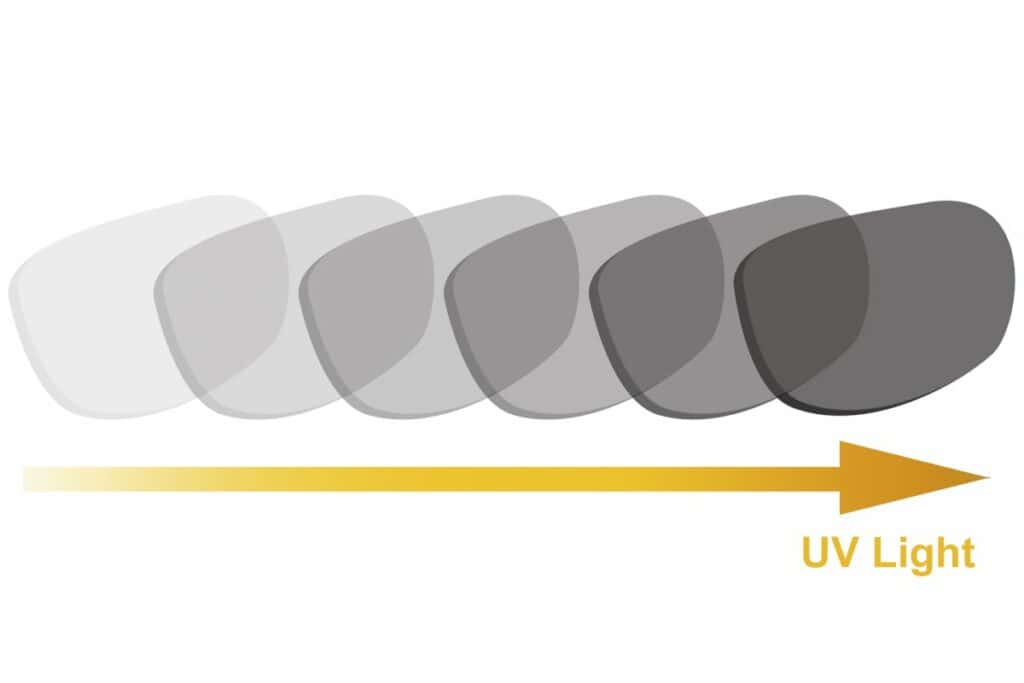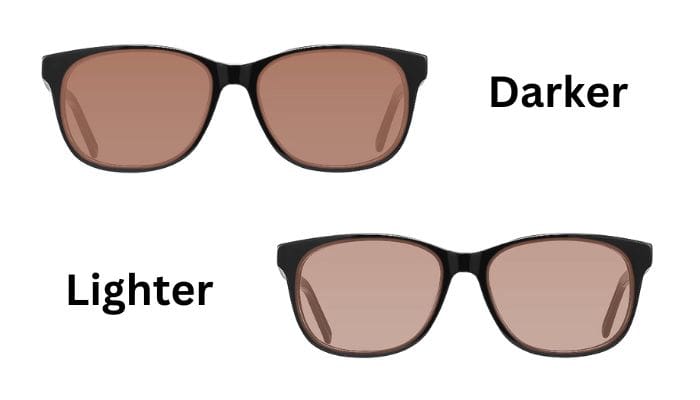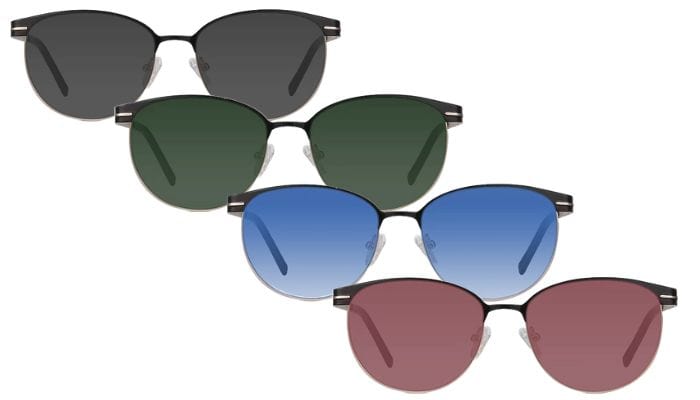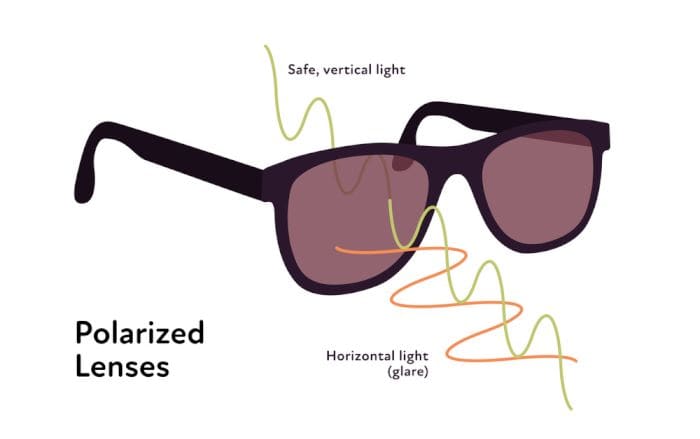If you wear glasses most of the time, people often wonder: are transition lenses worth getting? Also known as photochromic lenses, these light-intelligent lenses darken when exposed to UV rays while returning to clear indoors.
They’re definitely convenient if you’re running around from place to place and don’t want to deal with a separate pair of sunglasses. But are the cost of transition lenses worth the benefits?
In this post, we’ll look at the pros and cons of transition lenses to help you decide if they’re right for you. We’ll also discuss factors to consider when choosing a pair of photochromic lenses so you can make the right choice for you.
(This page contains affiliate links. OGR may receive compensation if you click a link and make a purchase.)
How Transition Lenses Work

How exactly do transition lenses darken and clear according to lighting conditions?
It’s all about the reaction of special dyes to ultraviolet (UV) light.
According to Lensmart, proprietary dyes applied to the lens undergo a chemical transformation when exposed to UV light.
When you step outside into the sunshine, UV rays hit the lenses, causing the dye molecules to rearrange.
This rearrangement process absorbs light and results in your lenses darkening.
But as soon as you step back indoors and your exposure to UV light reduces, the molecules return to their original structure, causing your lenses to clear up.
Pros of Transition Lenses

Comfort
Transition lenses are the epitome of comfort. No more squinting for several minutes when you first walk outside into the bright sun – your glasses automatically start darkening without you having to do a thing.
The level of tint also auto-adjusts based on the light, so you don’t have to deal with abrupt changes in lighting.
Protection
Transition lenses offer solid protection against UV rays and blue light, the notorious culprits behind eye damage, cataracts, and macular degeneration.
Having UV-blocking lenses on at all times ensures your eye health is consistently safeguarded, regardless of your surroundings.
Convenience
If there’s one word to sum up transition lenses, it’s convenience. You won’t have to keep switching glasses when you move indoors or outdoors, and you won’t have to carry a separate pair of sunglasses with you.
One and done!
Cost-Effectiveness
From a long-term perspective, transition lenses are a smart investment. They save you from the expense of buying a pair of prescription glasses and a separate pair of sunglasses or two.
So while you might spend a bit more upfront, they’re saving you money in the long run.
Cons of Transition Lenses
Like anything, transition lenses have some tradeoffs to keep in mind.
Brand Differences
Not all transition lenses are created equal. Different brands offer varying levels of darkness and tint, which can affect your vision quality and comfort.
Some might not darken as much as you’d like, while others might have a tint that doesn’t suit you.
Not Efficient in Vehicles
One of the biggest downsides to transition lenses is that they may not work well for driving.
That’s because your windshield does a great job of blocking UV light already (the trigger for the darkening process), which means your lenses might not darken as much as you’d want them to.
Delay In Darkening

Cloudy or cold weather can delay the transition time, causing a lag in the darkening or clearing process.
When the temperature is cooler, you may experience a slower response time in the lens’s ability to adapt.
In colder weather, the molecules in the photochromic material move more slowly, which means that your lenses will take longer to darken.
This can be a problem if you’re going from a warm building to a cold outdoor environment, for example, leaving you squinting outdoors or looking through darkened lenses when you return inside.
Higher Cost
And then there’s cost. Premium brands like Transitions® can add anywhere from 20 to 50% more to your bill compared to generic or house photochromic lens options.
So while they’re cost-effective in the long run, the initial price can be a bit of a pinch.
The good news is, house-brand photochromic lenses from many optical shops work nearly as well as Transitions® but won’t put as much of a dent in your wallet.
How To Get Cheap Transition Prescription Glasses
How to Choose the Right Transition Lenses
Level of Darkness and Tint

One of the main things you’ll want to think about when choosing transition lenses is the level of darkness or tint that will be comfortable for your eyes.
This is where Visible Light Transmission (VLT) comes into play. VLT refers to the percentage of light that a lens allows through to your eyes.
For instance, a VLT of 90% means the lens is letting through 90% of the available light, making it ideal for indoor use or overcast conditions.
On the other hand, a VLT of 20% would be perfect for a sunny day at the beach as it only lets 20% of the light through.
If you spend a lot of time outdoors exposed to bright sunlight, you want a lens with a lower VLT percentage. For indoor activities or cloudy days, a higher VLT is best.
Knowing how much VLT your glasses allow at the darkest level will make your transition lens-buying experience much smoother.
Color/Tint Choice

Your lens color when darkened isn’t only about aesthetics; different tints can impact your vision in different ways.
For example, gray lenses provide the most accurate color perception, making them a popular choice.
Brown or green lenses enhance contrast, which can be useful in certain outdoor conditions, like if you play golf.
Blue or purple lenses can be easier on the eyes for prolonged screen use, helping to reduce digital eye strain.
So, when choosing your lens color, think about how it could impact your daily activities and visual comfort.
Best Sunglass Lens Color for Driving
Alternatives to Transition Lenses
Transition lenses are fantastic, but they’re not the only game in town. If they don’t sound like your cup of tea, don’t worry – there are several great alternatives to consider:
Polarized Lenses

Can’t stand glare? Polarized lenses might be just the ticket.
They work by filtering out horizontal light waves, which drastically reduces glare and enhances contrast.
This makes them ideal for boating, fishing, cycling or any outdoor activity where blinding glare from reflective surfaces can affect your vision.
Clip-On Sunglasses
Nothing wrong with a low-tech solution, clip-ons are simply a separate set of tinted lenses that you clip onto your existing glasses for extra sun protection.
They’re a versatile and incredibly economical option that allows you to adapt to changing light conditions without changing glasses.
And when you’re indoors, simply unclip them and store them away. Easy peasy!
Prescription Sunglasses
Of course, you can always get yourself a pair of prescription sunglasses too.
Just like your regular glasses, they give you 20/20 vision and block harmful UV rays all while shading your eyes from the sun’s rays.
With prescription sunglasses, you can get a level of darkness that may not be available to you with transition lenses, making them a better alternative for those who spend extended periods of time outdoors.
Mirrored Sunglasses
You’ve probably seen these around – sunglasses with a shiny, reflective coating on the exterior of the lens.
But they’re not just for looking cool (though they definitely do that!). That mirrored coating helps to reflect light and glare away from your eyes, reducing eye strain.
They’re a particularly good choice for situations with intense light, like at the beach or in the snow.
Wrapping Up
So, are transition lenses worth it? If you spend your days running between the office and the field, or are super sensitive to light, transition lenses are certainly useful.
But if you spend a lot of time outdoors or need polarized lenses for a specific activity, you’ll likely want to invest in a separate pair of sunnies. Transition lenses are convenient, but they’re definitely better for everyday use than specialized tasks.
For environments where glare is a concern, or you’re consistently exposed to intense sunlight for extended periods, dedicated sunglasses will serve you better.
